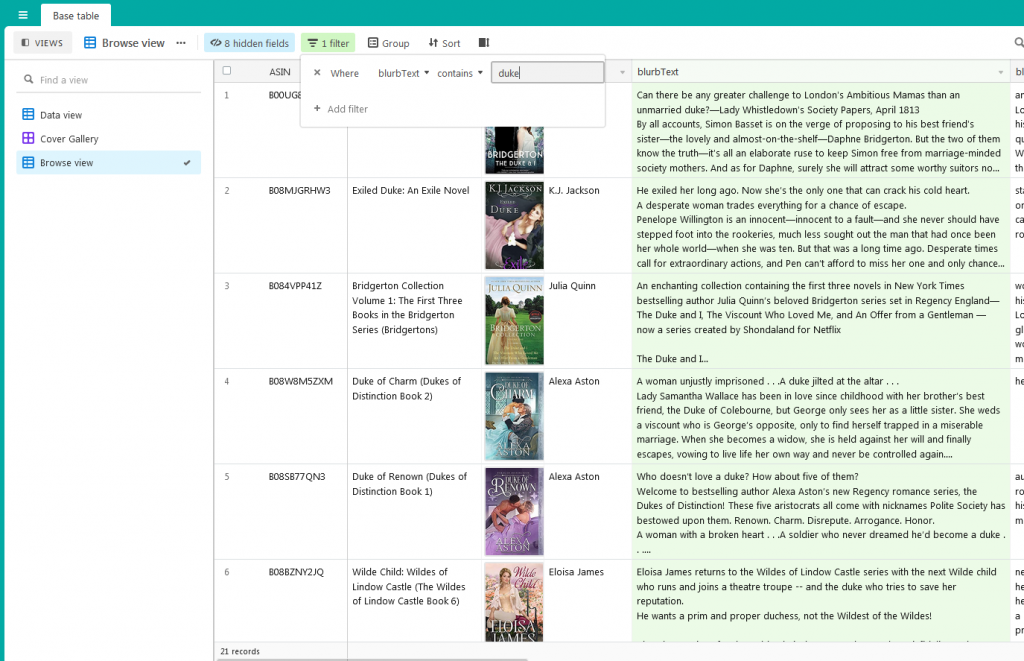Blurbs are (typically) the last thing readers see on the Kindle Store before they decide to buy your book. Blurb writing is challenging, and takes constant practice – but of all the elements we’re discussing in this series, it’s also the one which is cheapest to improve, and the most in your control.
To work on improving your blurbs using Kindletrends, let’s assume you have a book in progress, and you want to write a blurb for it. Start with the wordcloud:

The more frequent a word is, the bigger it is, so we can quickly see which are the most common words in blurbs. Focus on the nouns and adjectives here: nouns will often indicate the most common types of characters or situations in the genre, and adjectives will point to the feelings the author is trying to evoke in a reader. Note down the nouns and adjectives that are specifically relevant to your book. Finally, check the overall list of the most common words, and note down any other ones of interest you might have missed.
Now, open the Dashboard, and choose the Browse view. In the Browse view, filter the blurb text for the words you noted down above, like this:

Copy and paste the matching blurbs out to a Word document or another file. Rank the blurbs in order of their appeal to you; don’t think too much about this, just do it quickly. See if you can enlist someone else who isn’t a genre fiction writer to do this as well; comparing their ranking with yours may tell you about things you’ve missed.
Take the top three blurbs in order, and write the blurb for your book in the style of each of those top three. If they’re similar styles, then go further down your list until you have three different styles. Don’t worry if they don’t quite fit; you will rewrite them soon, and the purpose of this exercise is to get a feeling for different ways you can write your blurb.
Next, go back to the notes you made in Part One: Content, and compare the blurbs for those books with the story elements you identified. In a good blurb, every single sentence is there for a reason, and every single sentence indicates something about the book.
For the books you have read, what plot element or elements does each sentence in the blurb indicate to the reader? Pay particular attention to elements mentioned by readers in their reviews; these are good targets for emphasising in your own blurb.
Based on this knowledge, go back to your three different versions of your blurb and edit them. Your goal is to make each sentence in each of your blurb versions tell the reader something about your book – specifically, something that is a popular story element, and/or is mentioned by reviewers of other relevant books. This is quite a challenging exercise, and you will probably find one of these blurbs more appealing to you than the others. This is understandable, but don’t give up on the others just yet.
When this is done, try to find an audience on which to test your three blurbs. This can be colleagues, friends and family, or a genre-specific readers’ or writers’ group online. Present all three blurbs and ask people to rank them in order of their appeal; I find this gives me more useful feedback than just asking people whether they like a single blurb or not.
If you get a clear winner in terms of style, go with that; if you don’t, ask people what they like about their favourites, and try to combine them into a single blurb.
Further reading:
- The successful romance author and former copywriter Rosalind James has an excellent post about her blurb writing formula; this is the formula I start with for writing romance blurbs.
- Nicholas Erik (more recommendations later) has a ‘blurb cheat sheet’ which is invaluable, and a good general approach for all genres. In particular, his method of hand-copying blurbs, writing your own and then reading it aloud is very powerful.
- My current favourite book about blurbs is ‘Book Blurbs Unleashed’ by Robert J Ryan. This has a lot of useful insights about different types of taglines, and good examples of applying them to different genres.

